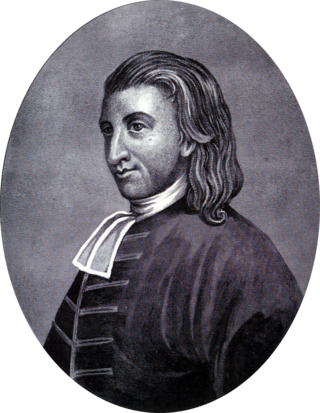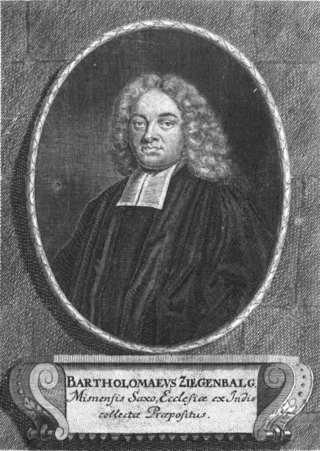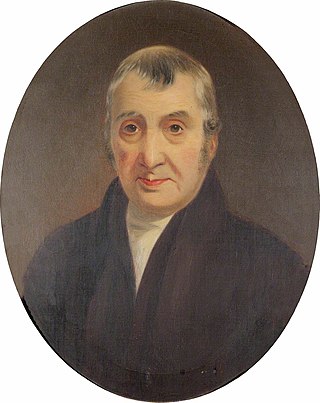
A dictionary is a listing of lexemes from the lexicon of one or more specific languages, often arranged alphabetically, which may include information on definitions, usage, etymologies, pronunciations, translation, etc. It is a lexicographical reference that shows inter-relationships among the data.
The Reverend Mr. Thomas Dilworth was an English cleric and author of a widely used schoolbook, both in Great Britain and America, A New Guide to the English Tongue. Noah Webster as a boy studied Dilworth's book, and was inspired partly by it to create his own spelling book on completely different principles, using pictures and stories of interest to children. By some accounts Dilworth was one of the few schoolbooks used by Abraham Lincoln. Published in 1740, by 1773, it was in its thirty-sixth edition. The last American edition was published in 1827 in New Haven, Connecticut. The full-page frontispiece portrait of the author was well known to generations of doodling school children and is mentioned in Dickens; in Sketches by Boz. Chapter X there is a humorous description of rowers' togs on the Thames:

Thomas Hearne or Hearn was an English diarist and prolific antiquary, particularly remembered for his published editions of many medieval English chronicles and other important historical texts.

The Commentaries on the Laws of England are an influential 18th-century treatise on the common law of England by Sir William Blackstone, originally published by the Clarendon Press at Oxford between 1765 and 1769. The work is divided into four volumes, on the rights of persons, the rights of things, of private wrongs and of public wrongs.

Thomas Boston was a Scottish Presbyterian church leader, theologian and philosopher. Boston was successively schoolmaster at Glencairn, and minister of Simprin in Berwickshire, and Ettrick in Selkirkshire. In addition to his best-known work, Human Nature in Its Fourfold State, one of the religious classics of Scotland, he wrote an original little book, The Crook in the Lot, and a learned treatise on the Hebrew points. He also took a leading part in the Courts of the Church in what was known as the "Marrow Controversy," regarding the merits of an English work, The Marrow of Modern Divinity, which he defended against the attacks of the "Moderate" party in the Church. Boston, if unduly introspective, was a man of singular piety and amiability. His autobiography is an interesting record of Scottish life, full of sincerity and tenderness, and not devoid of humorous touches, intentional and otherwise.

Thomas Blount (1618–1679) was an English antiquarian and lexicographer.
Texts of the Baháʼí Faith use a standard system of orthography to romanize Persian and Arabic script. The system used in Baháʼí literature was set in 1923, and although it was based on a commonly used standard of the time, it has its own embellishments that make it unique.
A pronunciation respelling for English is a notation used to convey the pronunciation of words in the English language, which do not have a phonemic orthography.

Bartholomäus Ziegenbalg was a member of the Lutheran clergy and the first Pietist missionary to India.

John Brent (1808–1882) was an English antiquary and novelist.

John Fell was an English congregationalist minister and classical tutor.
James Greenwood was an English grammarian.
Andrew Gray (1633–1656), was a Scottish divine. Gray was baptised on 23 August 1633. He was the son of Sir William Gray of Pittendrum, and Egidia Smith. He graduated from St Andrews University with an M.A. in 1651. He was licensed as a minister in 1653 and called on 5 September. He was ordained by the Protesters on 3 November 1653 but his ministry was a short one. He died on 8 February 1656.

John Gambold, was bishop of the Unitas Fratrum.

Ann Fisher was an English grammarian and successful author of several books. With A New Grammar (1745), she became the first woman to publish on modern English grammar, although Elizabeth Elstob had published a grammar of Anglo-Saxon in 1715. She was also the first woman to publish an English dictionary, and the first grammarian to suggest that masculine pronouns be used generically. Her daughter Sarah inherited and ran The Newcastle Chronicle which she co-founded.
John Frederick Archbold (1785–1870) was a barrister and legal writer. He was the first editor of the English criminal law textbook Archbold Criminal Pleading, Evidence and Practice, which is still routinely used in court today.
Revd John Trusler (1735–1820) was an eccentric English divine, literary compiler, and medical empiric.

Alexander Smith was a compiler of volumes of biographies. Presumed to be a nom de plume, but the details of the real authors are unknown.

Thomas Glass (1709–1786) was an English physician and medical writer.
William Dobson (1820–1884) was an English journalist and antiquary.












